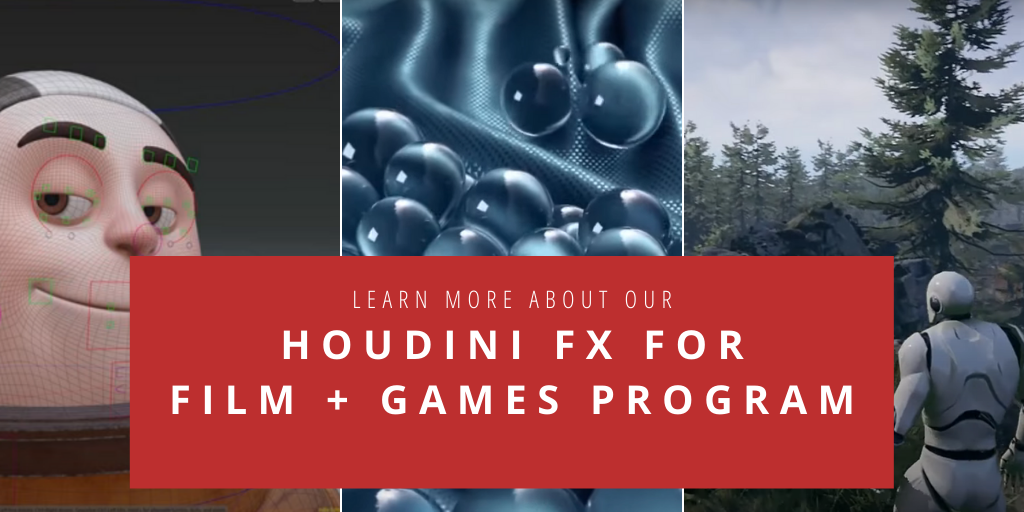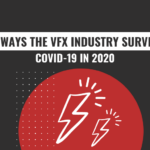WHY IS HOUDINI THE FUTURE OF 3D AND VFX?
SEE WHY HOUDINI, A STATE OF THE ART ANIMATION AND VFX PIPELINE TOOL IS CHANGING THE GAME.

Written by Rachel Kim
Explosions, earth-shattering destruction, glittering swirls of magic—these are the unavoidable spices of film and television. Today, much of these effects are created by a single tool—Houdini. But Houdini’s influence stretches even further. Though traditionally favoured by the effects departments, Houdini is a 3D and visual effects package that handles everything from modeling, animation, effects, character effects, lighting, and compositing. It has been embraced for its versatility and powerful capabilities.
“Houdini is very much designed and conceived as an end-to-end pipeline tool,” says Luca Pataracchia, Senior Production Specialist at SideFX and an industry-experienced Houdini artist. SideFX is Houdini’s software developer.
Houdini had an ethos of embracing procedural generation since its inception in 1996. The software has firmly established itself as a powerhouse in the industry.
1. A NEW WAY OF THINKING
Houdini’s unique and powerful capabilities come from its foundation in procedural generation and workflow. Unlike more conventional approaches, procedural workflows treat the process of creation as a series of distinct steps.

Consider a conventional sculptor approaching their work. They might have an idea in mind, but they don’t have an itemized list of actions to perform. They simply begin and make decisions as they go. Thinking procedurally on the other hand is like knowing the recipe and having an itemized list of actions in the order before even beginning.
“It requires that you think about the problem ahead of time,” says Pataracchia, “You think about where you want to end up and the steps to get there. Then, looking at the steps as discrete pieces, you come up with the best way to connect them.”
There are two main advantages to working procedurally.
-
Scalability
A procedural workflow makes it easier to do scale up. Let’s say you need to model and destroy 100 buildings. Done traditionally, you would need to create and destroy each individual building. Working procedurally with Houdini, you can set up the instructions for one building and replicate it 100 times over.
-
Easy to Make Changes
A procedural workflow is a lifesaver in production (or even when working on person work!) when artists are must make changes to a single shot or element. With a procedural system in place, you can simply make the changes or adjustments in the input instructions and the system will update the output. It’s much more convenient than needing to manually undo and redo hours of work.
The initial set up might take more time than it would to create the shot or element by diving in head first, but because of how easy it is to go back and make changes, a procedural workflow cuts back on a lot of the costs and saves much more time in the long run.
2. IT’S A JACK OF ALL TRADES
Houdini is versatile in more ways than one.
Not only is Houdini useful for all areas of the pipeline, it has a great input and output. This means it can easily read, write, and process all kinds of data formats—even custom ones—which accommodates a painless transition for any studio.
Houdini also benefits from SideFX’s collection of tools that support integration with third-party applications.
Houdini can be used throughout the entire pipeline, accommodates any data format and can integrate with third-party applications. It and saves time and budget through procedural generation, therefore it benefits users big and small. You don’t even have to be a studio. “You can totally be a guy working in their basement and leverage the power of Houdini,” says Pataracchia.
3. USED BY INDUSTRY ROCK STARS

Houdini is everywhere in the industry today. The VFX departments in film and television use it almost exclusively for simulations and particle systems. Houdini is also frequently used in commercial productions for its scalability, since quick and easy production of creative and dynamic ideas is crucial. As such, the industry is always looking for Houdini artists to tackle problems and particular tasks.
“Houdini artists tend to get paid more because Houdini can handle the tough jobs, right where other packages tend to fall down,” says Pataracchia. He also adds, “Because of that, if you know Houdini, people assume you’re smart.” Which is never a bad thing!
4. ANYONE CAN LEARN HOUDINI
“I’m firmly of the belief that anybody can become a Houdini artist,” says Pataracchia. Some of his most talented colleagues and friends became Houdini artists after unrelated careers as a cellist and a chemist, for example.
“There is a misconception that you have to be technical and that you have to be a programmer. You do have artists who are very technical and do come from a computer science background, but then you have artists like me who when to school for painting.”

For Patarrachia, it was enough knowing basic arithmetics and then picking up a few little things along the way over the 20 years he spent working in the industry.
Pataracchia does give a word of caution: “Not to discourage anybody but it’s hard work. Animation is hard work. But if you love it, you’re going to love doing the work.”
5. STEPS TO LEARNING HOUDINI
A big advantage for learning Houdini is the large, vibrant community, the active support of the developers, and the sheer amount of resources available online.
There are several avenues you can take to begin:

1) SideFX.com
At the top of the SideFX website [HYPERLINK], under Learn, you’ll find a tutorial section with tutorials (introductory and advanced) by both SideFX and the community at large. Also available on the site are the incredibly in-depth master classes: videos by the developers who actually write the software.
2) Forums
Forums are an excellent place for asking questions and seeing what other people are asking. Try logging on once a day to forums like the SideFX forum or ODForce [https://forums.odforce.net/]. Patarrachia particular recommends looking at the scene files posted by forum askers. “Because Houdini is procedural, you can work backwards from something that somebody created. So it’s very easy to learn from somebody’s setup because all the information is there.”
3) School
School programs—especially those led by industry-active instructors like InFocus’ 20-week Houdini program [HYPERLINK]—are always a great way to get access to quality instruction and to build a professional network of mentors and peers. Patarrachia notes that these connections are the best sources of information you can have.
“Getting information and training from people outside of the company is important because those are the people who use the product in production,” he says, “The people who are using it to generate content are the people with the best experience. They inform how our product works and what we need to improve on.”
As a flexible animation powerhouse, Houdini is becoming a ubiquitous asset in the industry. It’s no wonder that, with their unique procedural thinking skills, Houdini artists are in demand today.
For a strong, personalized springboard into the career, check out InFocus Film School’s upcoming Houdini Certificate Program. InFocus Film School’s 20-week Houdini Program is approved by SideFX. It is taught exclusively by industry professionals and designed to prepare anyone for this specialized niche.
To all Houdini hopefuls, Pataracchia says, “I envy that you’re at the beginning of it. So please enjoy and have fun.”
Related Links:
InFocus Film School Houdini For Film + Games Program






